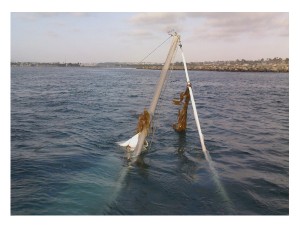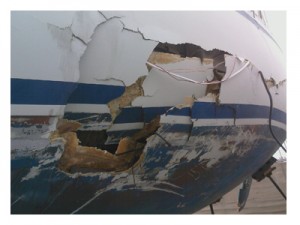TowBoatUS San Diego removes sunken sailboat from Mission Bay channel
The Mission Bay channel entrance is one of the most dangerous places boaters can find themselves in the San Diego area. Although most boaters feel that they are maintaining a safe distance from the jetty, the currents rip around the rocks, often putting boaters and their vessels in danger. This proved to be the case again as the jagged rocks of the Mission Bay jetty claimed another boat. A 30’ Yamaha sailboat lost power and before the mariner could do anything about it they were pounding on the rocks. If not for the immediate response by the Mission Bay Lifeguards the Vessel Assist crew would have been picking up pieces of the boat for days. The Lifeguards were able to pull the boat off of the rocks and rescue the crew of the stricken vessel, but in the few short minutes that the boat was aground the rocks dealt several catastrophic blows to it’s hull; by the time the lifeguards were able to tow the sailboat into the channel, it had already taken on enough water to cause it to sink. 
Being a busy holiday weekend, Vessel Assist had to act fast to remove the sunken vessel from the channel so that boaters could continue to safely transit the area. A Vessel Assist crew loaded salvage gear in the Vessel Assist Salvage truck and made their way to the Mission Bay Lifeguard station. The Vessel Assist Shelter Island happened to be about 30 miles off shore assisting a boater who ran over a 3” thick piece of purse seiner line. Having just finished the job 30 miles off and with the diver and his gear still on board, the Vessel Assist Shelter Island was ordered to hammer down and make top speed to Mission bay. An hour later the crew of the Shelter Island was loading the salvage gear onto the boat and underway to the Mission Bay channel entrance.
With many boaters breaking down over the busy weekend Vessel Assist San Diego had to perform a very difficult salvage “lift operation” with a three man crew and one salvage vessel. Normally, a job like this would involve a crew of 6 or 7 and two or three vessels, so Robert sent his “A” team: Salvage Master: Captain Tony Olson, Master salvage Diver: Shane Thompson (one of the foremost technical divers in San Diego), and Captain Eric Lamb, a seasoned captain as well as an excellent boat handler and salvage rigger.
Salvage diver Shane Thompson was already geared up from the previous dive 30 miles offshore and Eric had all the float bags pre-rigged for the lift. It took only a few moments after getting on scene for Captain Olson to start airing up the float bags and lift the boat.
 Due to the massive damage, floating the vessel would be next to impossible so the vessel was towed awash to Driscoll’s in Mission Bay for an emergency haul out. The speed with which the operation was completed allowed other boaters to transit, unobstructed, through the Mission Bay channel for the rest of the busy weekend.
Due to the massive damage, floating the vessel would be next to impossible so the vessel was towed awash to Driscoll’s in Mission Bay for an emergency haul out. The speed with which the operation was completed allowed other boaters to transit, unobstructed, through the Mission Bay channel for the rest of the busy weekend.
When entering or exiting Mission Bay follow here are a few simple guidelines to follow so that you won’t have to deal with the devistaing rocks of the Mission Bay Jetty:
1. Watch the weather. If there is a big swell and an outgoing tide, plan on a very rough trip out of the harbor, better yet just don’t go out.
2. When you reach the “turning basin” stop for a minute perform a bilge and engine check. This only takes a few minutes and it could save your boat and possibly your life.
3. When running in or out of the channel, run center of the channel and continue straight out at least 1 mile. When returning, pick a spot about a mile off and run straight in. Cutting the corners is just asking for trouble; a cough in your motor or some kelp in your props and you’re in line to meet the dreaded rocks.
4. In the event of an incident, set an anchor with plenty of scope immediately. Then, call for the San Diego Lifeguards on channel 16. They may only have to watch you from the tower until you fix your problem but at least they are aware of your situation and ready to launch a boat if they need to. The Lifeguards have a lot of fast boats and they know how to use them. Also, if you’re going to frequent Mission Bay and navigate the entrance it’s a good idea add some extra chain to your anchor. This will help set your anchor and possibly keep you from disaster. After you have safely anchored and contacted the Lifeguards you should call for Vessel Assist if you are unable to get going under your own power.
While waiting for Vessel Assist to arrive be aware of your surroundings as even the best anchors can drag in this area. If you feel like you’re dragging anchor do not pull it up to reset it, let out some more scope and inform the Lifeguards that you’re dragging anchor.
6. Lastly don’t wait until you think you’re in danger before you call for help. The Coast Guard, Lifeguards, Harbor Police, and Vessel Assist will gladly stand-down on cases when the boater gets going under their own power. Any of these agencies would be happy to get underway only to have to stand-down if it means that a safe boater was able to avoid an unfortunate and potentially life threatening incident.
These simple steps along with common sense will help keep you safe in Mission Bay.

